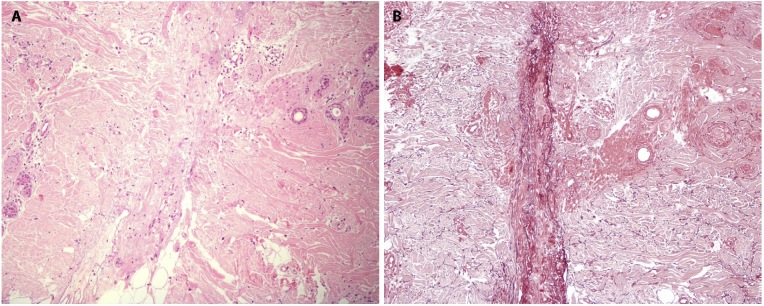Case Presentation
A 50-year-old Caucasian woman presented to the dermatology clinic complaining of hair loss over at least 5 years, without itching or redness. A 4 mm punch biopsy fixed in 10% buffered formalin was sent to our laboratory and then vertically bisected for analysis (Figure 1). It showed features of scarring alopecia, with a syringomatous proliferation in a fibrous zone; with orcein stain dense elastic fibers could be observed within a fibrous tract that extended below and above the insertion of the arrector pili muscle. The network of elastic fibers in the dermis was preserved. A diagnosis of pseudopelade of Brocq was made with clinicopathological correlation: the patient had reduced hair density with a scarred background on the interparietal area, towards the vertex, with no signs of inflammation.
Figure 1.
(A, B) Pseudopelade of Brocq: H-E x10 (A) and elastic stain-orcein x10 (B). The dermal elastic network is intact. Dense elastic fibers can be observed along a band of fibrous tissue which stretches below and above the preserved arrector pili muscle. Syringomatous hyperplasia can be observed (on the right).
Teaching Point
Elastic stains like Verhoeff-van Giesson and orcein are part of an alopecia histopathological routine study and can aid in the differential diagnosis of scarring alopecias. Elastic fibers are characteristically preserved and thickened in central centrifugal cicatricial alopecia and pseudopelade of Brocq, while other types of scarring alopecias like lupus erythematosus or lichen planopilaris show loss or absence of elastic fibers [1,2]. Histology needs to be correlated with clinical history and examination. While the existence of pseudopelade of Brocq as an independent clinical entity is still under debate, it being a diagnosis of exclusion, some recent molecular studies have begun to shed light in its distinction from lichen planopilaris [1,2]. Further research is still needed to clear up this long-standing controversy.
Footnotes
Funding: None.
Competing Interests: None.
Authorship: All authors have contributed significantly to this publication.
References
- 1.Bernárdez C, Molina-Ruiz AM, Requena L. Histologic features of alopecias: Part II: Scarring alopecias. Actas Dermosifiliogr. 2015;106(4):260–270. doi: 10.1016/j.ad.2014.06.016. [DOI] [PubMed] [Google Scholar]
- 2.Ramos-e-Silva M, Pirmez R. Disorders of hair growth and the pilosebaceous unit: Facts and controversies. Clin Dermatol. 2013;31(6):759–763. doi: 10.1016/j.clindermatol.2013.06.003. [DOI] [PubMed] [Google Scholar]



